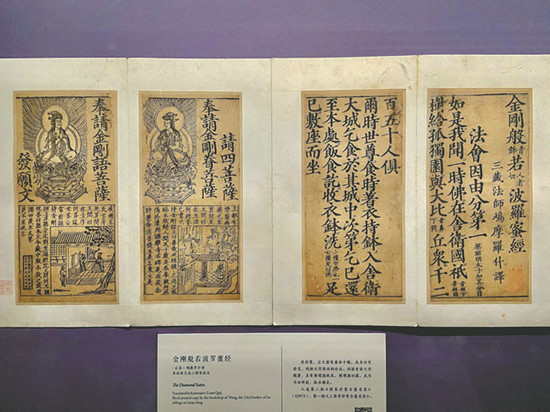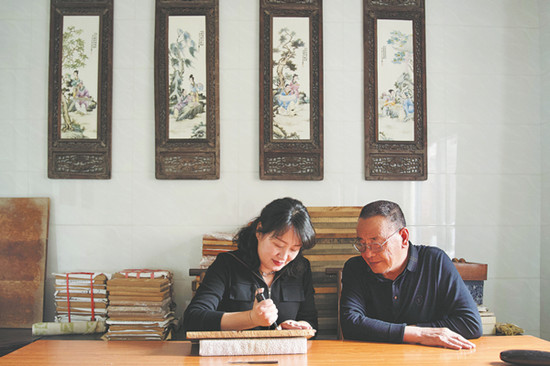
A woodblock-printed scroll of the Chinese version of the Diamond Sutra, dating to the Song Dynasty (960-1279), is now on display at the Shanghai Museum. CHINA DAILY
Woodblock printing transformed virtually everything about the written word centuries ago, but has faded in recent decades amid challenges ranging from wars to lasers. Three generations of one family in particular have continued to inscribe its legacy upon publishing, Yang Feiyue reports.
Editor's note: There are 43 items inscribed on UNESCO's Intangible Cultural Heritage lists that not only bear witness to the past glories of Chinese civilization, but also continue to shine today. China Daily looks at the protection and inheritance of some of these cultural legacies. In this installment, we discover how artisans inject new life into the age-old craft of woodblock printing.
Chen Yishi's presbyopic glasses magnify the Buddha emerging from beneath his chisel as he taps the tool to whittle the image into the ebony woodblock he's holding.
The septuagenarian retiree from Hangji town in the outskirts of Yangzhou, East China's Jiangsu province, still takes orders and is creating the Buddha block for a cultural company in Southwest China's Sichuan province. He also produces works purely for his own interest, such as his recently completed woodblock-printed classic anthology, Three Hundred Tang Poems.
"I need to keep my fingers nimble, or I'll get rusty," he says.
His living room walls are lined with variously sized woodblocks.
The craftsmanship required for the folk art, which made the national intangible cultural heritage list in 2006 and was inscribed on UNESCO's list in 2009, requires not only meticulous training but also great talent.

Chen Meiqi carves a woodblock under the guidance of her father, Chen Yishi. CHINA DAILY
Typically, 2-centimeter-thick blocks are hewn from fine-grained pear or jujube wood before they're polished and engraved.
Drafts of the words (Chinese characters) and images are then brushed onto extremely thin paper and proofed for mistakes before they're pasted onto the blocks. These designs provide guides for the artisans, who scratch them into the wood to generate the raised borders of words that will be coated with ink and then applied to paper pages.
Woodblock printing was initially used to publish Buddhist texts amid the religion's zenith in China during the Tang Dynasty (618-907).
It's considered one of ancient China's "four great inventions", along with papermaking, gunpowder and the compass.
The oldest surviving woodblock-printed text is a scroll of the Chinese version of the Diamond Sutra, which dates back to 868 and was discovered in the Mogao Grottoes in Dunhuang, Gansu province, in the early 20th century.
Woodblock printing enjoyed unprecedented development in Yangzhou during the Qing Dynasty (1644-1911), when Emperor Kangxi commissioned an official named Cao Yin to establish the Yangzhou poetry bureau. The publishing house's main focus was on engraving and printing books for the imperial collection, such as the 18th-century anthology, Quan Tang Shi (Complete Tang Poems). Kangxi wrote formal praise for this book, commending its compilation, carving, printing and binding.
The bureau brought skilled artisans to Yangzhou, where many quality private woodblock workshops sprung up in the following centuries. They ultimately played a vital role in preserving the complete set of techniques for woodblock printing until today.
Celebrated artisans
Hangji town in particular stood out as a woodblock-printing hub. Chen's grandfather opened Hangji's biggest woodblock-printing business during the reign of Emperor Guangxu.
Later, Chen's father took over the enterprise and produced many collector-grade classical books. He became a celebrated woodblock carver in the region as the industry boomed.
"The workshop had more than 30 skilled craftspeople, who were proficient at various tasks, such as typesetting, block carving, printing and binding," Chen recalls.
"Customers would come to Hangji from Shanghai, Zhejiang and even northeastern China to see the samples and place orders."
The craft suffered during the War of Resistance Against Japanese Aggression (1931-45) and again in the 1950s. Soon after, the mass adoption of digital typesetting and laser printing pushed woodblocks into the realm of niche novelty.
Chen says fewer than 30 people were engaged in the trade during the lowest ebbs.
The country emphasized cultural heritage following New China's founding in 1949, leading to the establishment of the Yangzhou Guangling Ancient Book Engraving Co Ltd, which has since then fulfilled its mission to preserve the ancient craft.
Chen's father began working at the publisher, and Chen studied under his dad, starting from the age of 14, as the group's youngest apprentice.
"I had to get up at 7 in the morning and worked until my vision got blurry around 10 at night," Chen recalls.
Chen has developed expertise in carving various Chinese calligraphy styles, such as cursive, seal and official characters.
He is particularly adept at the widely used Song Dynasty (960-1279) typeface known for its blocky, clear and balanced appearance.
The artisan and colleagues at Guangling have also restored many historical books and documents, and brought watercolor-block printing back from the verge of extinction.
Indeed, he has devoted himself to preserving all the ancient methods used in the trade that, centuries ago, issued in a paradigm shift for written language that ultimately transformed the world.
"The most commonly used wood comes from wild fruitless pear trees," he explains.
"It has a moderate hardness and fine grain, and its size doesn't change much when it's soaked or dried. These qualities make it relatively easy to carve and good for applying ink."
Blocks are soaked in water for six or seven months to remove the sugar, so they don't rot or get eaten by bugs.
"The secret is to make sure that, while they're soaking, they don't leave the water for even a second until it's time to dry them out completely. Otherwise, even an instant of exposure to air can cause convection cooling that can compromise the wood's structure," Chen says.
Afterward, they're dried in the shade for a month before they're resized and reshaped.
Then, a light layer of paste is slathered on the dry blocks before pieces of thin paper with written characters or sketched images are placed atop the area that will be engraved once the adhesive dries.
Brushstrokes are specially executed to enable precision cutting of the blocks to ensure every character is clear and graceful.
Images are the trickiest, Chen explains.
"The wood grain runs horizontally. So, when carving the expression in a person's eyes, for example, you have to pick a place to etch vertical lines, so the eyes appear particularly dark when printed to make them vivid and lively," he says.
"The lines must be smooth to present the face, the hands and even the motion of the fingers."
A craftsperson may only be able to carve a dozen characters a day, and a 100-page book could take an experienced artist a year or two to finish.
Etches of eras
When Chen's father was on his deathbed, Chen promised he would carry forward the craft. He has since extended this legacy to his daughter, who has worked at Guangling since 2001.
In 2007, the Ministry of Culture and Tourism named Chen as a national inheritor of woodblock printing.
His daughter, Chen Meiqi, still marvels at some of the techniques her father has mastered that virtually nobody else can execute.
"Dad can automatically place nonstandard manuscripts straight on the woodblocks before carving, like it was done in the old days," she explains.
"That's something we can't do now, since every step has been standardized."
Chen Meiqi initially worked as a jade sculptor before her father persuaded her to instead carve woodblocks as the number of practitioners of this ancient printing method dwindled.
"My father had 20 students before 2005, but only one continued his training," she recalls.
"I could feel he desperately wished I could carry on this legacy."
Chen Meiqi started with Song-type characters.
"The learning process is arduous. Different fonts require different levels of detail. The Yangzhou style is especially strict because it follows imperial standards."
For example, the three pointed dots in the Chinese character xin (heart) are slightly different and should take on the respective shapes of a water drip, a kidney and a melon seed, she says.
"Even the slightest mistake, a literally hair-thin margin of error, can result in significant differences when printed. One faulty character renders the entire block unusable," she says.
"There are no shortcuts or tricks to mastery — just continuous practice," she says, quoting her father.
The most elemental skills require at least half a year of training, and it takes around a year to be able to carve even simple characters, she says.
"It's not until the second year that you can start learning while assisting with actual pieces. And it takes about three years before you can even try to work independently."
Chen Meiqi heads the learning center Guangling founded in 2007 to enable anyone who is interested to study and appreciate the craft under experienced artisans' guidance.
"I can clearly see a growing interest in woodblock carving," she says.
"We've been invited to give more lectures and trainings at companies and schools across the country."
The Guangling printing house is also striving to come up with new applications for the ancient craft.
"It can be used to print in a variety of traditional styles, like modern books that use old binding methods, or to reproduce ancient Chinese books for collectors," she says.
The publisher has also developed popular products, ranging from lampshades to fans, which creatively feature woodblock printing.
Chen Meiqi starts every day at Guangling sitting in front of a pile of woodblocks.
She says she plans to propagate this craft for the rest of her life — and beyond — ensuring its legacy remains inscribed across centuries past and yet to come.
"I'll do this as long as I live," she says.
"And history has shown that these works, produced with special ink and paper, will last for a thousand years."